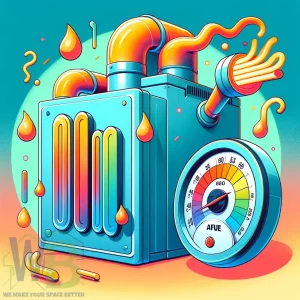What is VAV in HVAC? VAV stands for Variable Air Volume in the HVAC world: Heating, Ventilation, and Air Conditioning. It’s a system that changes the airflow to maintain a comfortable temperature.
A VAV system is useful in offices or schools, where different rooms need different temperatures.

Quick Summary
| Section | Key Points |
|---|---|
| What is VAV in HVAC? | – VAV stands for Variable Air Volume. – Controls air flow for temperature regulation. – Efficient and provides customized comfort. |
| VAV Components | – Main parts: VAV box, thermostat, dampers. – Each part plays a role in adjusting air flow and temperature. |
| How does a VAV system work? | – Responds to temperature changes in zones. – Central unit generates air; VAV adjusts the flow. – Adaptable and energy-efficient. |
| What is a VAV Box? | – Controls air volume to spaces. – Types: Single-duct and Dual-duct. – Key for customized comfort and energy efficiency. |
| Conclusion | – VAV systems offer a smart way to manage temperature. – Ideal for large buildings for better comfort and energy savings. |
The Idea Behind VAV
The main idea of VAV is to control how much air is cooled or heated and sent into different spaces. This is different from older systems that always push the same amount of air no matter what. VAV is all about flexibility and efficiency.
Why VAV Matters
- Energy Efficient: VAV systems save energy. They only use what is needed to keep each area at the right temperature.
- Improved Comfort: People in different building parts can have the desired temperature. This makes VAV systems popular in large buildings.
- Adaptable: These systems can adjust to changes, like when more people are in a room or the outside weather changes.
VAV systems are a smart way to manage temperature in big buildings. They balance comfort with saving energy.

VAV Components
A VAV system in HVAC has several key parts. Each part plays a role in adjusting the airflow and temperature. Let’s break down these components.
Main Parts of a VAV System
- VAV Box: This is the core component. It controls the air that goes into a space located in the ductwork.
- Thermostat: Each zone or room has a thermostat. It measures the temperature and tells the VAV box how much air is needed.
- Dampers: These are like gates in the VAV box. They open or close to control airflow.
How These Parts Work Together
- Communication: The thermostat signals the VAV box about the temperature.
- Adjustment: Based on this signal, the dampers in the VAV box adjust. They control how much air enters a zone.
Importance of Each Component
- VAV Box: The decision-maker adjusts air flow as needed.
- Thermostat: Acts like a sensor, constantly checking the temperature.
- Dampers: They physically control the air, like turning a tap on and off.
Each component in a VAV system is important. They work together to make sure each part of a building gets just the right amount of air.
How Does a Variable Air Volume (VAV) System Work?
Understanding how a variable air volume (VAV) system works is key to appreciating efficiency. It’s like having a smart, automatic system that knows how much air each part of a building needs.
Basic Operation
- Responding to Temperature: Each area or zone in a building has its own temperature needs. The VAV system uses thermostats in these zones to monitor the temperature.
- Adjusting Air Flow: If a zone needs more cooling or heating, the VAV box opens its dampers more to let in more air. If less is needed, it reduces the airflow.
The Role of the Central Unit
- Central Control: The central HVAC unit generates the cooled or heated air. The VAV system then decides how much air to send to different zones.
- Efficiency: The central unit can run more efficiently by only using as much air as needed. This means less wasted energy and lower costs.
Smart Adjustments
- Adaptability: The VAV system can adjust quickly. If a meeting room fills up with people, it sends more cool air. When the room empties, it cuts back.
- Fine-Tuning: The system isn’t just on or off. It fine-tunes the air flow, making small changes for optimal comfort and efficiency.
A VAV system is smart, flexible, and efficient. It’s designed to provide just the right air for heating or cooling, saving energy and keeping people comfortable.

What is a VAV Box?
A VAV box, or Variable Air Volume box, is a fundamental component in a VAV HVAC system. It’s like a control valve for air entering different building areas. Let’s dive deeper into what a VAV box is and why it’s important.
The Function of a VAV Box
- Airflow Control: The VAV box controls how much cool or warm air goes into a specific area. It adjusts the volume of air based on the needs of that space.
- Responding to Thermostat Signals: The box receives signals from the thermostat in its zone. Depending on the temperature needed, it changes the airflow.
Types of VAV Boxes
- Single-Duct VAV Boxes: These are the most common type. They have one duct bringing air in and adjusting the volume for a single zone.
- Dual-Duct VAV Boxes: These have two ducts, usually for hot and cold air. They mix these to reach the right temperature.
Importance in HVAC Systems
- Customized Comfort: Each VAV box ensures its area gets the right air. This leads to better comfort in different parts of a building.
- Energy Efficiency: VAV boxes help the system save energy by controlling airflow so precisely. They prevent overcooling or overheating.
The VAV box ensures that each part of a building gets just the right temperature. It’s a smart and efficient way to handle air distribution.
VAV in HVAC Conclusion
We’ve explored the VAV system in HVAC, a smart solution for managing air temperature and flow in buildings. From understanding what VAV is to the crucial role of the VAV box, we’ve covered the key aspects of this efficient and adaptable system.
VAV systems represent a significant advancement in HVAC technology, offering comfort and efficiency. By understanding how these systems work, from their basic operation to the function of a VAV box, you can appreciate the benefits they bring to modern buildings.
Whether you’re a building manager, a homeowner, or simply interested in HVAC technology, the knowledge of VAV systems is invaluable. It helps you make informed decisions about heating and cooling solutions that are both cost-effective and environmentally friendly.







